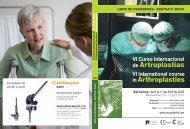cadera / hip - Active Congress.......
cadera / hip - Active Congress.......
cadera / hip - Active Congress.......
Create successful ePaper yourself
Turn your PDF publications into a flip-book with our unique Google optimized e-Paper software.
JUEVES / THURSDAY<br />
226<br />
Operative Techniques<br />
A. Three Degrees External Rotation Relative<br />
To The PCA<br />
1. Advantages<br />
a) Simple<br />
b) Accurate In Most Knees With Limited<br />
Deformity & Minimal Bone Erosion<br />
2. Disadvantages<br />
a) Anatomic Variations22<br />
• TEA Externally Rotated Vs. PCA<br />
(Average 3.6o)<br />
• TEA Vs. PCA Range: 7o External<br />
Rotation To 1o Internal Rotation<br />
b) Less Reliable In Valgus Knees<br />
(Hypoplastic Lateral Femoral<br />
Condyle) 11,21<br />
c) Can’t Use In Revision TKA<br />
B. Parallel To Transepicondylar Axis<br />
1. Advantages<br />
a) Laboratory Studies Suggest TEA<br />
Parallel To The Flexion – Extension<br />
Axis and Perpendicular To The<br />
Mechanical Axis<br />
b) Enhances Central Patellofemoral<br />
Tracking<br />
c) Improved Tibiofemoral Kinematics<br />
• Reduced Femoral Condylar<br />
Lift-Off13<br />
• Assists In Creation Of Rectangular<br />
Flexion Gap21<br />
d) TEA Available In Revision TKA<br />
e) Accurate In Valgus Knees With<br />
Hypoplastic Lateral Femoral<br />
Condyles<br />
2. Disadvantages<br />
a) Often Difficult To Accurately Locate10,14,29,30<br />
C. Perpendicular To The Anteroposterior<br />
Axis<br />
1. Advantages<br />
a) Easy To Locate In Primary TKA3<br />
b) Enhances Central Patellofemoral<br />
Tracking 2,29<br />
2. Disadvantages<br />
a) Absent In Revision TKA<br />
b) Less Reliable If:<br />
• Severe Trochlear Dysplasia<br />
• Advanced Patellofemoral Arthritis<br />
(Trochlear Bone Erosion)<br />
D. Flexion Gap Method<br />
1. Femoral Component Placement Parallel<br />
To Tibial Resection Surface With Equal<br />
Collateral Ligamentous Tension<br />
2. Advantages:<br />
a) Better Flexion Stability / Reduced<br />
Femoral Condylar Lift-Off<br />
b) More Reproducable10<br />
c) Available In Revision TKA<br />
3. Disadvantages<br />
a) Unreliable If Ligamentous Imbalance<br />
Or Insuffi ciency<br />
b) Unreliable If Inaccurate Tibial Resection<br />
IV. Femoral Component Rotation:<br />
SUMMARY<br />
A. Advantages & Disadvantages Of Each<br />
Technique<br />
B. No Technique Is Perfect<br />
C. Solution: Use All Available Methods<br />
V. Tibial Component Rotation<br />
A. Many Landmarks Utilized<br />
1. Tibial Tubercle<br />
2. Midcoronal Tibial Axis<br />
3. Posterior Tibial Condylar Axis<br />
4. Transmalleolar Axis<br />
5. Second Metatarsal<br />
6. Align With Femoral Component<br />
B. No Single Landmark Highly Accurate<br />
C. Good Scientifi c/Clinical Studies Lacking<br />
D. Critical For Central Patellofemoral<br />
Tracking<br />
1. KEY – Don’t Internally Rotate ! ! !<br />
BIBLIOGRAPHY<br />
1. Akagi M, Matsusue Y, Mata T, Asada Y, Horiguchi<br />
M, Iida H, Nakamura T: Effect of rotational<br />
alignment on patellar tracking in total knee arthroplasty.<br />
Clin Orthop, 366:155-163, 1999.<br />
2. Anouchi YS, Whiteside LA, Kaiser AD Milliano<br />
MT: The effects of axial rotational alignment of<br />
the femoral component on knee stability and





